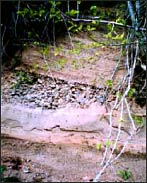| Forest Road Deactivation Practices | |
| in the Pacific Northwest | |
| 7 - Erosion Protection | Streams, Cut & Fill Slopes, Fine-Textured Soils |
Erosion protection at deactivated crossing sites must focus on protecting newly exposed mineral soil. If there is a risk of erosion or downcutting of the newly established stream bottom, place armour or rip rap in its base. In your peak flow estimate, you should be generous in your estimate of the high water mark due to possible alterations to the stream channel from construction. Erosion protection along the channel sides should be placed accordingly. Ideally, 50% of the armour should be 10% bigger than the biggest rocks moved by the watercourse. Key in the armour and force it into mineral soil with the back of the excavator bucket. This is critical at the outfall of the cross ditch where it blends into the original stream channel. Simply "sprinkling" rock onto the surface is very ineffective and expensive. Catch basins in combination with armouring (non-fish creeks) can be very effective in preventing sediment transport. However, in permanent deactivation, you must ensure that the catch basin, when full, does not become an unrepairable hazard or environmental liability.

Oversteepened fill slopes must be partially or fully pulled back to create a stable fill slope, and then revegetated to provide surface protection Unstable cut slopes must be either sloped back to an acceptable angle, buttressed by retrieved pullback materials, or supported by rock armour. Partially completed works (see picture on right) or cutslope stabilization without proper foundation, slope angle, or design have a tendency to fail after a short time. To avoid costly errors, get the advice of a professional engineer or geoscientist.
If rock is unavailable, a lift of gravel placed on geotextiles can provide sufficient weight to prevent the erosion of fine-textured soil from cut slopes.  However, a gravel blanket cannot make an unstable cutslope stable. Recognize underground flows that were intercepted during the original road construction, and distinct layers of fine-textures sands and silts. They can best be addressed by across-grade or longitudinal french drains. Care must be taken not to combine several underground flows from french drains into a single surface watercourse unable to accommodate the increased water flows. Remember that doubling the velocity of water allows it to move particles 32 times bigger and 64 times heavier. Consequently, you should avoid creating water accumulations and V-shaped cross-ditches with steep gradients. Disperse water and slow it down wherever possible.
However, a gravel blanket cannot make an unstable cutslope stable. Recognize underground flows that were intercepted during the original road construction, and distinct layers of fine-textures sands and silts. They can best be addressed by across-grade or longitudinal french drains. Care must be taken not to combine several underground flows from french drains into a single surface watercourse unable to accommodate the increased water flows. Remember that doubling the velocity of water allows it to move particles 32 times bigger and 64 times heavier. Consequently, you should avoid creating water accumulations and V-shaped cross-ditches with steep gradients. Disperse water and slow it down wherever possible.
| 7 - Erosion Protection |
| Next |
||
|
Erosion Protection 7
|
|
|
©1999 - 2002 Flip Productions Limited Used with permission by CulvertBC |